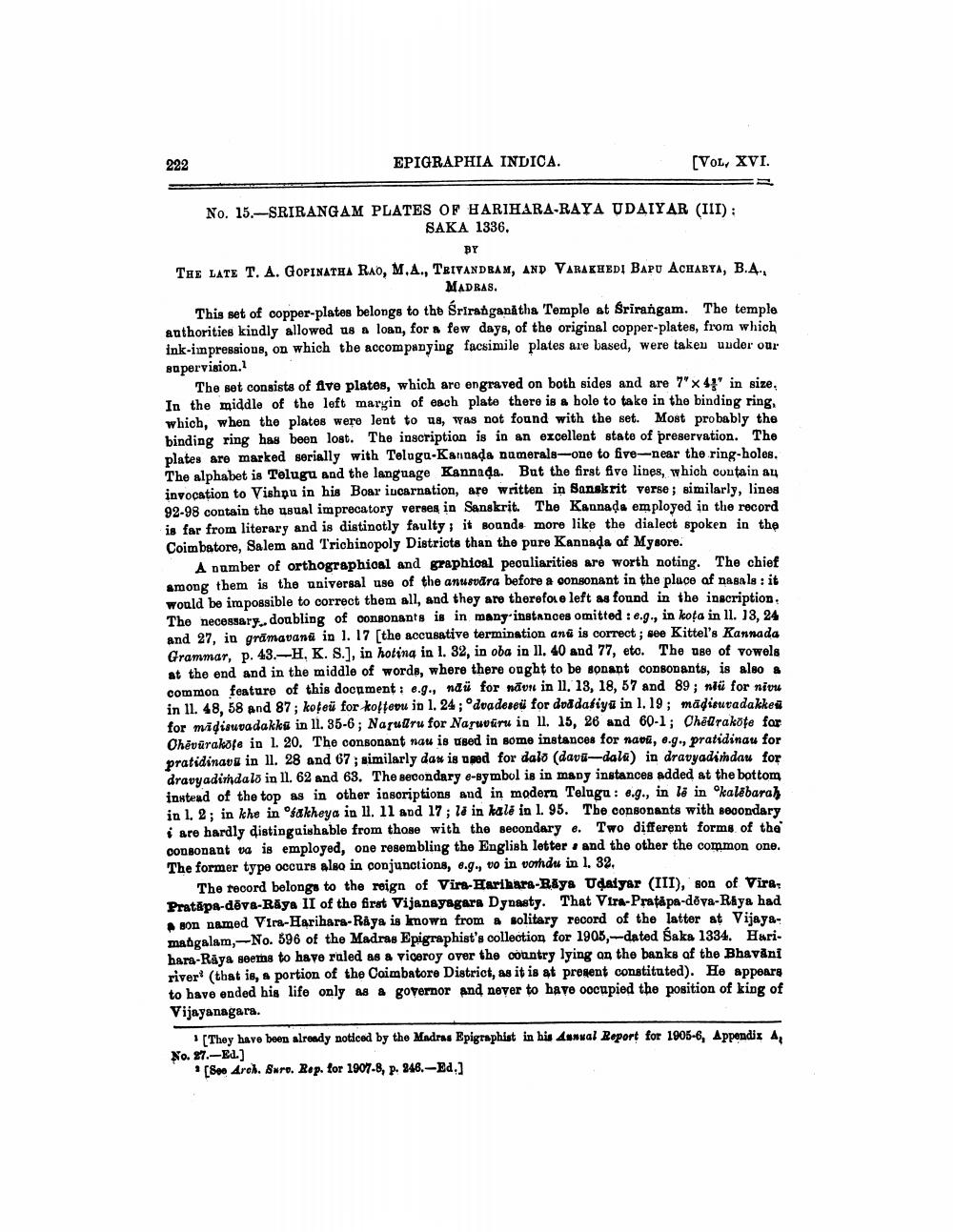________________
222
EPIGRAPHIA INDICA.
(VoL, XVI.
No. 15.-SRIRANGAM PLATES OF HARIHARA-RAYA UDAIYAR (III):
SAKA 1336.
BY THE LATE T. A. GOPINATHA RAO, M.A., TRIVANDRAM, AND VARAKHEDI BAPU ACHARYA, B.A..
MADRAS. This set of copper-plates belongs to thd Sriranganātha Temple at Srirangam. The temple anthorities kindly allowed us a loan, for a few days, of the original copper-plates, from which ink-impressions, on which the accompanying facsimile plates are based, were taken under our supervision.
The set consists of five plates, which are engraved on both sides and are 7' 41' in size. In the middle of the left margin of each plate there is a bole to take in the binding ring, which, when the plates were lent to us, was not found with the set. Most probably the binding ring has been lost. The inscription is in an excellent state of preservation. The plates are marked serially with Teluga-Kannada numerals--one to five-near the ring-holes. The alphabet is Telugu and the language Kannada. But the first five lines, which contain au invocation to Vishnu in his Boar incarnation, are written in Sanskrit verse; similarly, lines 92-98 contain the usual imprecatory verses in Sanskrit. The Kannada employed in the record is far from literary and is distinctly faulty; it sounds more like the dialect spoken in the Coimbatore, Salem and Trichinopoly Districts than the pure Kannada of Mysore.
A number of orthographical and graphical peouliarities are worth noting. The chief among them is the universal use of the anus dra before a consonant in the place af nasals : it would be impossible to correct them all, and they are therefore left as found in the inscription. The necessary. doubling of consonants is in many instances omitted : 6.9., in kota in 11. 13, 24 and 27, in grdmavand in 1. 17 (the accusative termination and is correct; see Kittel's Kannada Grammar, p. 43.-H, K. S.], in hoting in l. 32, in oba in 11. 40 and 77, eto. The use of vowels at the end and in the middle of words, where there onght to be sonant consonants, is also a common feature of this document: 6.g., ndü for nãun in 11, 13, 18, 57 and 89; ndü for nivu in 11. 48, 58 and 87, kofeü for koftevu in 1.24 ; doadesed for dod dabiya in 1, 19; mādisuradakkeu for midisuvadakka in 11. 35-6; Naruuru for Naruvuru in 11. 15, 26 and 60-1; Chēlrakote for Ohëvūrakote in l. 20. The consonant nau is used in some instances for nava, 6.g., pratidinau for pratidinavo in ll. 28 and 67; similarly dax is used for dalo (dava-dala) in dratyadindau for dravyadimdalo in 11. 62 and 63. The secondary e-symbol is in many instances added at the bottom instead of the top as in other insoriptions and in modern Teluga : 8.g., in le in "kalebara) in l. 2; in khe in fakheya in 11. 11 and 17; li in kale in l. 95. The consonants with secondary i are hardly distinguishable from those with the secondary e. Two different forms of the consonant va is employed, one resembling the English letter and the other the common one. The former type occurs also in conjunctions, 6.g., vo in vorhdu in 1. 32.
The record belongs to the reign of Vira-Harihara-Błys Udaiyar (III), son of Vira: Pratápa-dēva-Raya II of the first Vijanayagara Dynasty. That Vira-Pratapa-dēva-Raya had
son named Vira-Harihara-Raya is Imown from a solitary record of the latter at Vijaya. madgalam, No. 596 of the Madras Epigraphist's collection for 1905,-- datod Saks 1334. Harihara-Raya seems to have ruled as a viceroy over the country lying on the banks of the Bhavani river! (that is, a portion of the Coimbatore District, as it is at present constituted). He appoare to have ended his life only as a governor and never to have oocupied the position of king of Vijayanagara.
[They have been already noticed by the Madras Epigraphist in his dunval Report for 1905-6, Appendix , No. 27.-Ed.)
* [8o Arch. Swro. Rep. for 1907-8, p. 948. -Ed.]




